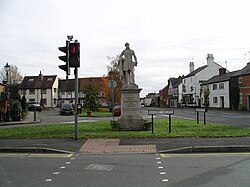Dunchurch
| Dunchurch | |
|---|---|
 Daventry Road and the Square viewed from Rugby Road in the village centre |
|
| Dunchurch shown within Warwickshire | |
| Population | 2,938 (2011) |
| OS grid reference | SP485712 |
| Civil parish |
|
| District | |
| Shire county | |
| Region | |
| Country | England |
| Sovereign state | United Kingdom |
| Post town | RUGBY |
| Postcode district | CV23 |
| Dialling code | 01788 |
| Police | Warwickshire |
| Fire | Warwickshire |
| Ambulance | West Midlands |
| EU Parliament | West Midlands |
| UK Parliament | |
Dunchurch is a civil parish and village on the south-western outskirts of Rugby in Warwickshire, England. The 2001 census[update] recorded a population of 2,842 in the village, increasing to 2938 at the 2011 Census.
The earliest historical reference to Dunchurch was in the Domesday Book in the 11th century which mentioned a settlement called Doncerce.
The core of the village has been declared a conservation area because it has many buildings of historical interest. Some of the buildings date to the 15th century are timber framed and still have traditional thatch roofs.
For centuries Dunchurch was an important staging post on the coaching roads between London and Holyhead (now the A45 road) (classified as B4429 through the village) and Oxford and Leicester (now the A426 road). At one point 40 stagecoaches and the regular mail coach every day would stop at Dunchurch. Coaching inns developed in Dunchurch to accommodate these visitors (the "Dun Cow", the "Bell" and the "Star"). Other inns were the "Mother Red Cap", "Crown" and "Red Lion". The "Bell" and "Red Lion" premises were destroyed by German high explosive bombs in November 1940. All other properties can still be seen today.
Many notable people have stayed at Dunchurch. Most notably, in 1605 the Gunpowder Plotters stayed at the Red Lion Inn (reputed to be the private residence now called 'Guy Fawkes House') in Dunchurch awaiting news of Guy Fawkes's attempt to blow up the Houses of Parliament. If he had been successful they planned to kidnap the King's daughter Elizabeth of Bohemia from nearby Coombe Abbey.
...
Wikipedia

